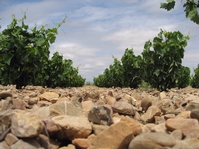Terroir is a controversial, and little understood, topic that has resonated in wine circles over the last decade. According to the Oxford Companion to Wine, “No precise English equivalent exists for this quintessentially French term and concept.” Then, shedding some light on the suggested obscurity, the OCW goes on for nearly two full pages with an in-depth definition, but neatly sums up the concept with: “Terroir, a much-discussed term for the total natural environment of any viticultural site.”
The whole murky concept got me second-guessing myself about whether I am a terroir denier or a terroir skeptic. I began to lean heavily toward skeptic after finishing judging, for the first time, at the Grand Harvest Awards. The idea behind GWA is to see if judges can detect terroir differences in specific wines made from the same grape but in different parts of California, or wherever. A panel of judges would face a selection of Chardonnays from Napa Valley, Russian River Valley, Anderson Valley, Monterey, Santa Barbara County and so forth. After  deciding if a wine deserves a medal or not, each judge had to put his or her “terroir impressions” in writing. For me, it was an exercise in futility.
deciding if a wine deserves a medal or not, each judge had to put his or her “terroir impressions” in writing. For me, it was an exercise in futility.
Then, the other day, I read a short item on “Wine Sur,” the on-line site about Argentine wines, touting the work of Pedro Parra, a terroir consultant and soils specialist who, for four years, has led the “Terroir Project.” Para and his team looked at soil compositions in pits in the ground in the Mendoza departments of Agrelo and La Consulta. Among his findings, Para claims that the clay soils of Agrelo, “Due to its composition, means depth, silt, Napa Valley ripening and alcohol.” Para also maintains that the soils of La Consulta, composed of rocks, calcareous deposits, clay, sand and gravel, are “perfect” for Malbec and Chardonnay.
In my view, there is one major problem with these proclamations about the contributions of soil composition as a component of terroir. Winemaking gets in the way. There is no doubt that certain elements in soil have a profound impact on the vigor and flavor of grapes and thus, the resulting wine, the same way that fertilizer fortifies the soil, promoting better crops. But while these components may be transferred to the grape juice, the impact of terroir is mostly masked by many of the techniques employed in modern winemaking, but none more so than the influence of oak on Chardonnay.
It would not be a stretch to say that the majority of Chardonnays on the market today are influenced by the use of malo-lactic fermentation, lees contact and the use of oak barrels as  the primary fermentation vessel and for the aging of the wine or both. So, how does anyone find terroir differences in a wine with that much winemaking?
the primary fermentation vessel and for the aging of the wine or both. So, how does anyone find terroir differences in a wine with that much winemaking?
At the Grand Harvest Awards, I tried year after year, judging Chardonnay and other varietals, but rarely found any differences from one wine to the next that I could honestly attribute to the terroir of a particular vineyard site or region. Further, even if I did find something different, I was never sure if it was an aspect of winemaking or an actual terroir nuance and then how was I to describe what I just tasted.
One final thought. Most wine consumers I talk with do not know or understand the supposed influence of terroir on finished wine, nor do they care. It’s a geek factor that interests grape growers and winemakers more than consumers, so why is there so much talk about terroir directed to consumers? E-mail me at [email protected].
6
